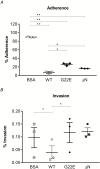A Rare Mutation in SPLUNC1 Affects Bacterial Adherence and Invasion in Meningococcal Disease
- PMID: 31504285
- PMCID: PMC7201419
- DOI: 10.1093/cid/ciz600
A Rare Mutation in SPLUNC1 Affects Bacterial Adherence and Invasion in Meningococcal Disease
Erratum in
-
Correction to: A Rare Mutation in SPLUNC1 Affects Bacterial Adherence and Invasion in Meningococcal Disease.Clin Infect Dis. 2022 Aug 24;75(1):184. doi: 10.1093/cid/ciac263. Clin Infect Dis. 2022. PMID: 35608985 Free PMC article. No abstract available.
Abstract
Background: Neisseria meningitidis (Nm) is a nasopharyngeal commensal carried by healthy individuals. However, invasive infections occurs in a minority of individuals, with devastating consequences. There is evidence that common polymorphisms are associated with invasive meningococcal disease (IMD), but the contributions of rare variants other than those in the complement system have not been determined.
Methods: We identified familial cases of IMD in the UK meningococcal disease study and the European Union Life-Threatening Infectious Disease Study. Candidate genetic variants were identified by whole-exome sequencing of 2 patients with familial IMD. Candidate variants were further validated by in vitro assays.
Results: Exomes of 2 siblings with IMD identified a novel heterozygous missense mutation in BPIFA1/SPLUNC1. Sequencing of 186 other nonfamilial cases identified another unrelated IMD patient with the same mutation. SPLUNC1 is an innate immune defense protein expressed in the nasopharyngeal epithelia; however, its role in invasive infections is unknown. In vitro assays demonstrated that recombinant SPLUNC1 protein inhibits biofilm formation by Nm, and impedes Nm adhesion and invasion of human airway cells. The dominant negative mutant recombinant SPLUNC1 (p.G22E) showed reduced antibiofilm activity, increased meningococcal adhesion, and increased invasion of cells, compared with wild-type SPLUNC1.
Conclusions: A mutation in SPLUNC1 affecting mucosal attachment, biofilm formation, and invasion of mucosal epithelial cells is a new genetic cause of meningococcal disease.
Keywords: human genetics; meningococcal disease; mucosal immunity; sepsis; severe infectious disease.
© The Author(s) 2019. Published by Oxford University Press for the Infectious Diseases Society of America.
Figures






Similar articles
-
Human genetics of meningococcal infections.Hum Genet. 2020 Jun;139(6-7):961-980. doi: 10.1007/s00439-020-02128-4. Epub 2020 Feb 17. Hum Genet. 2020. PMID: 32067109 Free PMC article. Review.
-
SPLUNC1/BPIFA1 contributes to pulmonary host defense against Klebsiella pneumoniae respiratory infection.Am J Pathol. 2013 May;182(5):1519-31. doi: 10.1016/j.ajpath.2013.01.050. Epub 2013 Mar 15. Am J Pathol. 2013. PMID: 23499554 Free PMC article.
-
Genome-wide association studies reveal the role of polymorphisms affecting factor H binding protein expression in host invasion by Neisseria meningitidis.PLoS Pathog. 2021 Oct 18;17(10):e1009992. doi: 10.1371/journal.ppat.1009992. eCollection 2021 Oct. PLoS Pathog. 2021. PMID: 34662348 Free PMC article.
-
The role of glyceraldehyde 3-phosphate dehydrogenase (GapA-1) in Neisseria meningitidis adherence to human cells.BMC Microbiol. 2010 Nov 9;10:280. doi: 10.1186/1471-2180-10-280. BMC Microbiol. 2010. PMID: 21062461 Free PMC article.
-
Global estimate of Neisseria meningitidis serogroups proportion in invasive meningococcal disease: A systematic review and meta-analysis.Microb Pathog. 2019 Sep;134:103571. doi: 10.1016/j.micpath.2019.103571. Epub 2019 Jun 1. Microb Pathog. 2019. PMID: 31163252
Cited by
-
Human genetics of meningococcal infections.Hum Genet. 2020 Jun;139(6-7):961-980. doi: 10.1007/s00439-020-02128-4. Epub 2020 Feb 17. Hum Genet. 2020. PMID: 32067109 Free PMC article. Review.
-
Immunomodulatory function of the cystic fibrosis modifier gene BPIFA1.PLoS One. 2020 Jan 13;15(1):e0227067. doi: 10.1371/journal.pone.0227067. eCollection 2020. PLoS One. 2020. PMID: 31931521 Free PMC article.
-
Paediatric Personalized Research Network Switzerland (SwissPedHealth): a joint paediatric national data stream.BMJ Open. 2024 Dec 26;14(12):e091884. doi: 10.1136/bmjopen-2024-091884. BMJ Open. 2024. PMID: 39725440 Free PMC article.
-
Genetic variants linked to the phenotypic outcome of invasive disease and carriage of Neisseria meningitidis.Microb Genom. 2023 Oct;9(10):001124. doi: 10.1099/mgen.0.001124. Microb Genom. 2023. PMID: 37874326 Free PMC article.
-
Genetic variability in COVID-19-related genes in the Brazilian population.Hum Genome Var. 2021 Apr 2;8:15. doi: 10.1038/s41439-021-00146-w. eCollection 2021. Hum Genome Var. 2021. PMID: 33824725 Free PMC article.
References
-
- Yazdankhah SP, Caugant DA. Neisseria meningitidis: an overview of the carriage state. J Med Microbiol 2004; 53:821–32. - PubMed
-
- Virji M. Pathogenic neisseriae: surface modulation, pathogenesis and infection control. Nat Rev Microbiol 2009; 7:274–86. - PubMed
-
- Mace SE. Acute bacterial meningitis. Emerg Med Clin North Am 2008; 26:281–317, viii. - PubMed
-
- Pace D, Pollard AJ. Meningococcal disease: clinical presentation and sequelae. Vaccine 2012; 30(Suppl 2):B3–9. - PubMed

